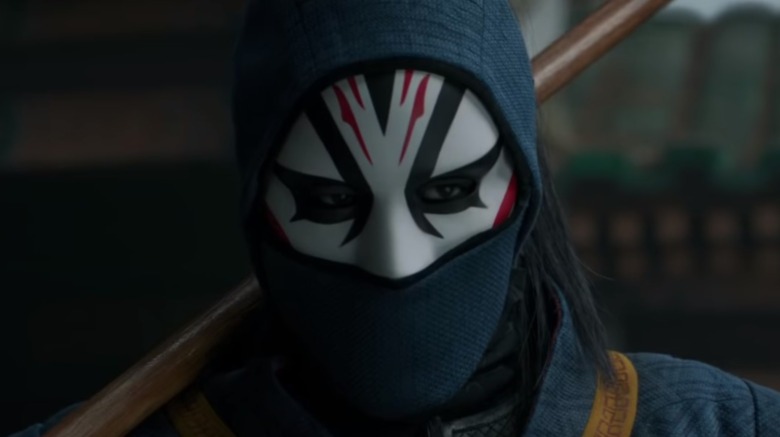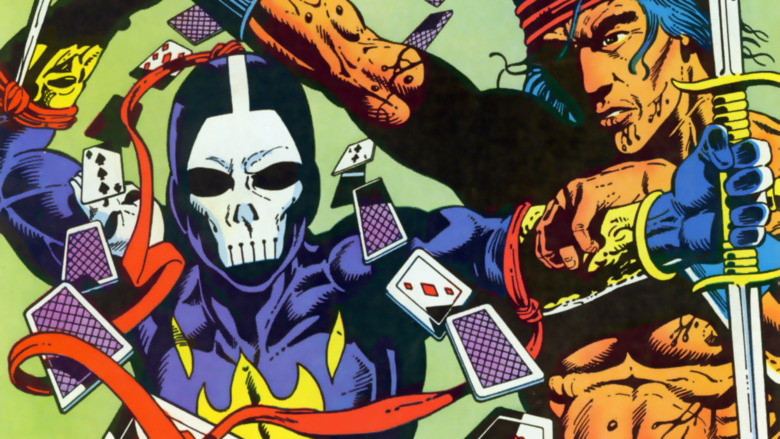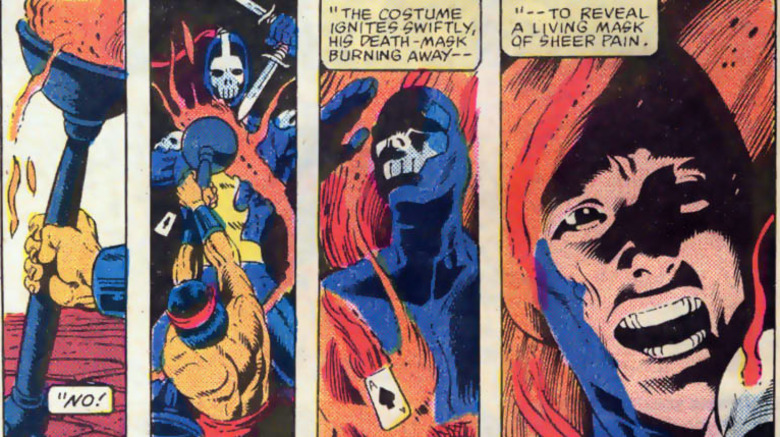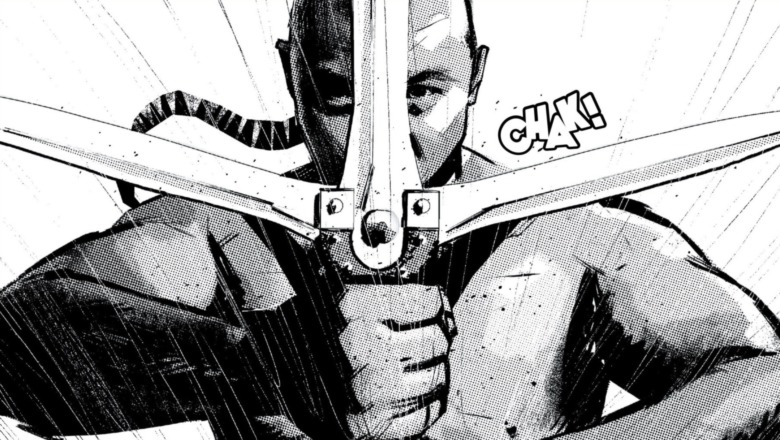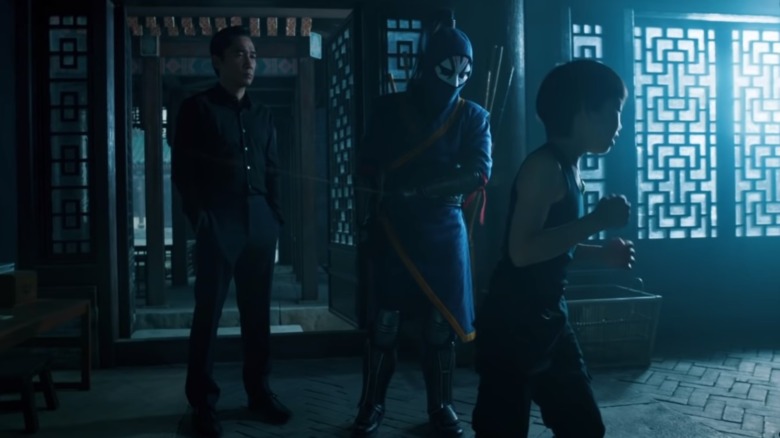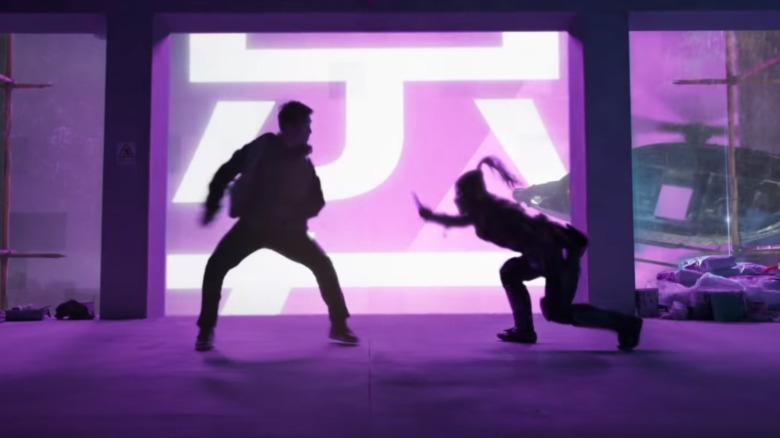The Untold Truth Of Death Dealer
As a general rule, villains get more intriguing the less you know about them — Darth Vader was at his most interesting before he started describing sand to people, and nobody cared who Bane was until he put on the mask, adding an air of mystery to his face's southern hemisphere.
By that metric, there's no bad guy more compelling than Death Dealer, the antagonist making their Marvel Cinematic Universe debut in "Shang-Chi and the Legend of the Ten Rings." During the film's teaser trailer, fans got around eight seconds of footage cluing them in to what the baddy will be getting up to in the film. From the looks of it, mostly hitting things. Maybe, just maybe, getting hit by things, too.
Mostly, though, Death Dealer is a black box of a character, shrouded in mystique and a head-to-toe costume that just screams "I'm going to have a big reveal moment later where it turns out that I'm actually the main character's mother or love interest or favorite children's television host." For hints at what Death Dealer's death deal might be, we turn to the source material, and the character's long, rich history of Marvel comic book stories.
All four of them.
Death Dealer got dealt a bad hand
Like a handful of other MCU bad guys relegated to origin story-solo adventure movies, Death Dealer isn't exactly an A-lister on the supervillain scene. In point of fact, the character has only appeared in four issues of the comics.
His arc started in "Master of Kung Fu" #115. Shang-Chi, at this point working as a field agent with MI-6, was put on the trail of Li Ching-Lin, a fellow agent with a brutal streak. Described as ambitious, universally capable, and willing to do anything in order to move up the chain of command, Li Ching-Lin was actually working for Dr. Fu Manchu, Shang-Chi's nefarious father, disguised at this point as Wang Yu-Seng. Shang-Chi was sent to "find, incapacitate, and deliver" his fellow agent, but lost the upper hand during a brief showdown.
Ching-Lin ran off to find his boss, who handed down some classic big-boss supervillain wisdom, stating: "The time has come to remove your mask ... by donning a new mask." His declaration proves once again that you don't have to make sense when you're in charge.
The Brief and Frightening Reign of Death Dealer
Helpfully, Fu Manchu had a new mask already set aside for Li Ching-Lin. A little suspicious? Sure, but it was weird when the Emperor had a Hayden Christensen-sized Darth Vader costume and appropriately proportioned cybernetic limbs just sitting around, too. Say what you will about bad guys, they always seem to have a phenomenal tailor on retainer.
"You must now become ... Death Dealer," Fu Manchu declares, and sets Ching-Lin up with a real hat-on-a-hat look: a black unitard with white Northstar boots, gold flames on the tummy, skulls on the face and shoulders, crimson stegosaurus spikes running down the back, and long, flowing red scarves on the back of the head and elbows. Death Dealer also receives a pair of triple-bladed knives and — somewhat inexplicably — a mercurial obsession with playing cards.
Unfortunately, his tenure as a villainous toady is a short one. After two more appearances in issues #116 and #117 of "Master of Kung Fu," largely spent driving a truck or piloting a helicopter, Death Dealer comes to his inevitable end when Shang-Chi, like so many noble heroes, straight up burns him alive, igniting his costume with a flaming brazier and then hanging out for a full seven panels, while his adversary screams, collapses, and dies.
The legacy of Death Dealer
Death Dealer's time in the comics was relatively unspectacular and a little muddled, but he was remarkable in one way: After being killed in "Master of Kung Fu" #118, he accomplishes what few comic book characters ever do by staying dead.
But it's like they say: "Dying is easy, avoiding a multi-generational legacy of martial arts revenge is hard." 2009's "Shang Chi: Master of Kung Fu" one-shot saw the introduction of a new member of the Death Dealer family — the villain's son, Huo Li.
In a beautifully written and illustrated segment of the comic entitled "Once Upon A Time In Wan Chai," written by Mike Benson and featuring art from Tomm Coker and C.P. Smith, Shang-Chi is hunted down by the child of his old enemy. The setup is familiar to fans of martial arts stories — Huo Li has trained his entire life to fight the man who killed his father. Wielding a reimagined version of his old man's cutlery, he gets down to the business of street brawling
What happens next is a startlingly thoughtful throwback to an obscure story from three decades prior. Shang-Chi thinks back to the hyper-violent death that he inflicted on a misguided dude during the shock-and-awe comics of the 1980s, and reconsiders whether Death Dealer really needed to die. He incapacitates Huo Li, acknowledges his emotional trauma, and walks away from the fight. You don't see that kind of consideration over the death of a no-name villain very often, and the stark monochrome artwork juxtaposes like gangbusters against the binary morality that you tend to see in comic book punch-em-ups.
What's changed about Death Dealer?
Like so many MCU character adaptations, Death Dealer is getting a glow-up for their big screen debut. The onesie is gone, as are the very glam boots and the skull motif.
Instead, Death Dealer's new outfit seems all about subtle allusions to the original. The skull-adorned head-covering has been replaced with an ornamental mask, thick face veil, and hood. The golden flames are gone, hinted at by the new uniform's yellow lining, and there's no sign of a single decorative spine running down the back. Most damningly, Death Dealer's iconic, confounding, ever-present cloud of playing cards is nowhere to be seen. The elbow ribbons managed to make the cut, but the triple-bladed cutting implements have been scrapped in favor of daggers and the aforementioned kid-smacking stick.
While all of this points to a work uniform that's, at the very least, more functional and less visually busy, it doesn't answer the most important question of all: How flammable is it?
But who is that masked man (or maybe woman)?
As mentioned earlier, Death Dealer's most exciting quality going into "Shang-Chi and the Legend of the Ten Rings" is the fact that we know suspiciously little about them. Even with the movie's release date having been pushed back several times, not a word about their true identity has managed to leak. Disney hasn't so much as announced who plays Death Dealer in the movie, and promotional materials and toy packaging — generally a wellspring of accidental reveals — have been dry as a bone. The character's action figure box simply reads "Death Dealer is one of the most formidable opponents Shang-Chi has ever faced." Thanks for nothing, Hasbro.
From what can be gleaned from "Shang-Chi's" teaser trailer, it appears that Death Dealer has been working for the Mandarin for decades — they appear in what looks like a flashback to Shang-Chi's childhood, motivating the young hero during his studies with the old "hit him with a stick" method. It's possible that whoever is under that complex outfit means more to Shang-Chi than we're being told. Is Death Dealer his mother, who never got a name in the comics? His sibling, Sister Hammer, introduced in the comics last year? Was Death Dealer Agatha all along? Maybe Death Dealer is Mephisto. Maybe we're all Mephisto.
Or maybe it's Dallas Liu, the "PEN15" actor who's been credited with an undisclosed role in the film. We'll just have to wait and find out.
"Shang-Chi and the Legend of the Ten Rings" hits theaters on September 3, 2021.
